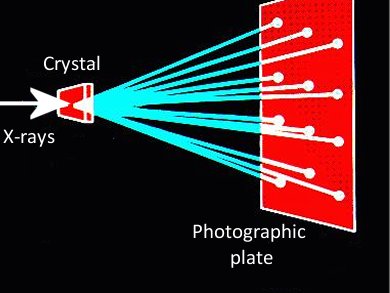June 8th 2012 marks the 100th anniversary of the first report of X-ray diffraction by Max von Laue and colleagues, University of Munich, Germany. Von Laue came up with the idea to send a beam of X-rays through a copper sulfate crystal and record the results on photographic plates (pictured). He persuaded his colleagues Walter Friedrich and Paul Knipping – both of whom had more practical experience with X-rays than von Laue himself – to perform the experiment, the results of which showed diffraction spots surrounding the central spot of the primary beam.
The discovery came 17 years after Wilhelm Conrad Röntgen had demonstrated the existence of X-rays and their nature was still undetermined. Physicists suspected that X-rays were a form of electromagnetic radiation, but had been unable to obtain solid evidence for their diffraction. Estimations placed the wavelength of X-rays in the region of 0.4–0.6 Å.
Around the same time, crystallographers were becoming convinced of the space-lattice-like construction of crystals, a topic that von Laue discussed with his friend Paul Peter Ewald. In one conversation, Ewald revealed that the spacing between lattice points was possibly a suitable distance to create interference of X-rays if the estimated wavelengths were correct.
Von Laue’s experiment presented evidence for the wave nature of X-rays and the space lattice of crystals at the same time as the diffraction spots were caused by X-rays impinging on a regular array of scatterers, in this case, the repeating arrangement of atoms within the crystal. The scatterers produced a regular array of spherical waves which interfered destructively in most directions, but constructively in some, giving the bright spots on the photographic plate.
Within a year of the discovery of X-ray diffraction, William Lawrence Bragg had exploited the phenomenon to solve the first crystal structure and determined the rule governing the diffraction pattern as:.gif)
2dsinθ = nλ
where d is the spacing between diffracting planes, θ is the incident angle, n is any integer, and λ is the wavelength of the beam (right).
The discoveries of von Laue and Bragg gave birth to two new sciences, X-ray crystallography and X-ray spectroscopy, and two Nobel Prizes: Max von Laue “for his discovery of the diffraction of X-rays by crystals” in 1914 and to Bragg and his father, Sir William Henry Bragg, “for their services in the analysis of crystal structure by means of X-rays” in 1915.
Max von Laue is the answer to Guess the Chemist (6), which gives details about his career.
- Max von Laue and the discovery of X-ray diffraction in 1912,
M. Eckert,
Annalen der Physik, 2012, 524(5), A83–A85.
DOI: 10.1002/andp.201200724 - The Discovery of the Diffraction of X-rays in Crystals — A Historical Review,
G. Hildebrandt,
Cryst. Res. Technol. 1993, 28(6), 747–766.
DOI: 10.1002/crat.2170280602


